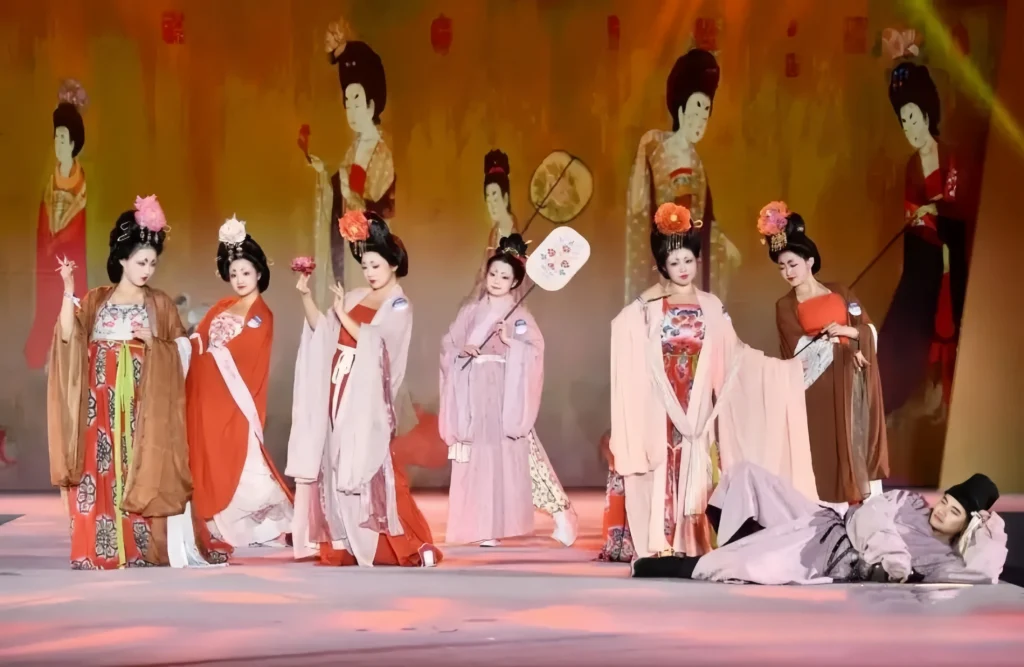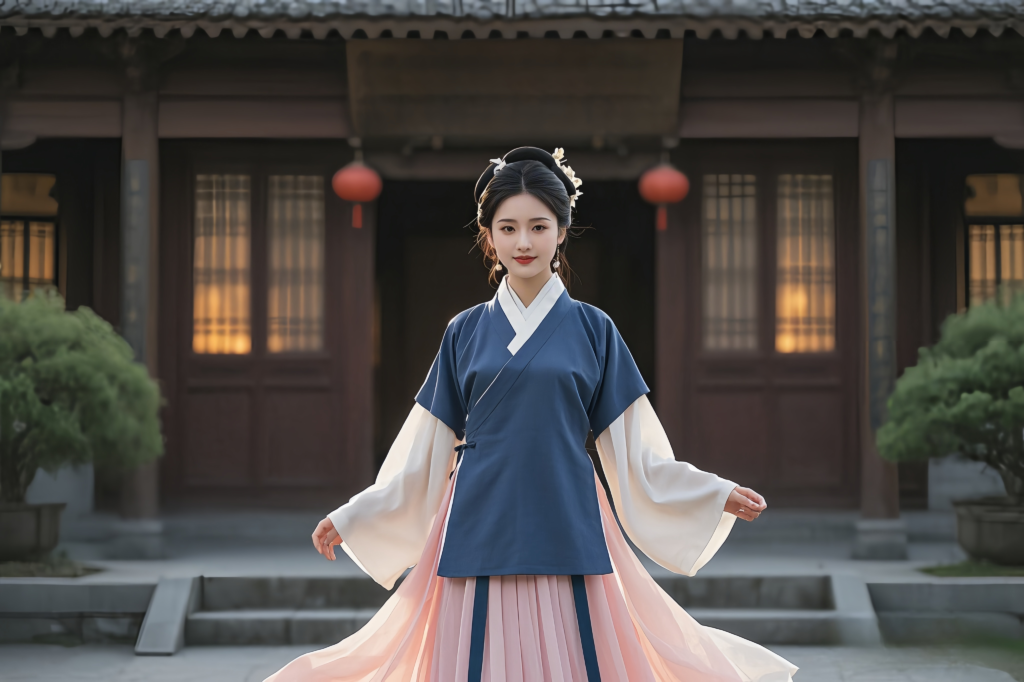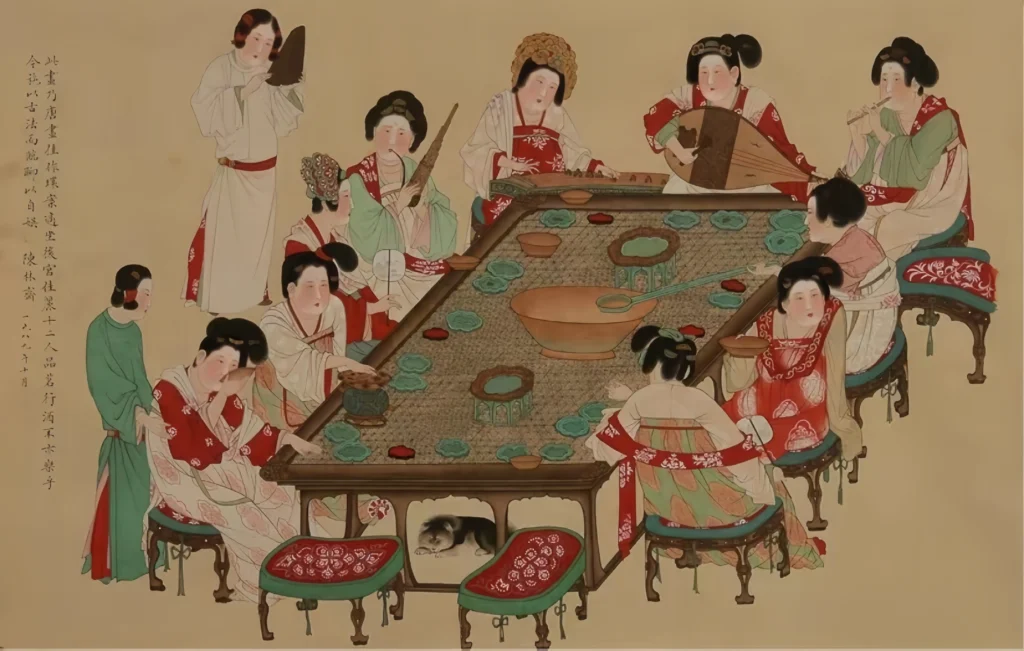Evolution of the Mamian Skirt

The Mamian Skirt has truly become popular! Let’s dive into the history and origins of the Mamian Skirt.
Recently, Yang Mi appeared in a Mamian Skirt outfit, which quickly sparked a wave of Mamian Skirt fashion online. The Mamian Skirt is really trending! So, let’s take a detailed look at the historical origins of the Mamian Skirt!

The Historical Evolution of the Mamian Skirt:
Based on existing records, the mainstream skirt styles in the Hanfu system originated from the pre-Qin period’s multi-piece spliced one-piece wrap skirts. The prototype came from the Song dynasty’s swirling skirt, a two-piece wrap skirt, which emerged during the late Song and early Yuan dynasties, and was finalized during the Ming dynasty.
During the Qing dynasty, after the collapse of the Hanfu system, the clothing styles like the railing skirt, fish-scale skirt, and moonlit skirt remained, with the cuts gradually deviating from and losing the original structural features of the Hanfu.
In the Republican period, a single style could not resist the strong invasion of Western-style clothing. The style gradually transformed into a set-in type, and this style became marginalized, surviving only in a few elements.

Part 1
The Mamian Skirt originates from the evolution of the “wrap-style” skirt and is unrelated to the “set-in-style” skirts of the Liao and Jin Khitan, etc.
According to sculptures and historical records, the multi-piece spliced one-piece wrap skirt can be traced back to the Yin and Shang dynasties. It matches the “three fronts and four backs” characteristic described in the records.

At the same time, the skirt shape from non-Han Chinese cultures around 3,000 years ago is the “waist garment.”

The single skirt unearthed from the Mǎshān Chu Tomb of the Warring States period, dating back over 2,000 years, has a structure composed of multiple joined fabric panels, forming a one-piece wraparound design.

This skirt is the earliest known physical skirt ever discovered. The single skirt unearthed from the Mawangdui tomb of the Western Han dynasty, about 2,100 years ago, shows no substantial difference from pre-Qin period skirts, except for slight variations in piece sizes, edge treatment, etc.


A single skirt unearthed from the Bijiatan tomb of the Wei-Jin period, about 1,800 years ago, is also a multi-piece spliced skirt, a one-piece wrap, and it is pleated. Compared to the pre-Qin and Han dynasty skirts, it shows no significant differences, only that the color of the spliced pieces differs, making it an interlaced skirt.

In contrast, the “Hu clothing” skirts from the Han and Wei periods had distinct structural differences.

The yellow woolen skirt unearthed from the Shampula tomb in Xinjiang, dating from the Han and Jin periods, clearly shows that the non-Han Chinese skirt in the Hanfu system was set-in, with pleating applied at the top of the skirt.
One is wrap-around, and the other is set-in. It is impossible to conclude that the skirts in the Hanfu system originated from Hu clothing.
Next, let’s take a look at the interlaced skirt from the Tang dynasty, about 1,000 years ago. Its structure is a multi-piece spliced skirt, a one-piece wrap, with pleating. Compared to the Han and Wei skirts, it shows no substantial difference.

Tang dynasty “Hu clothing” was characterized by “set-in” styles. For example, in the “Wei Shu” Volume 102, it is recorded: “Their custom is that men cut their hair, wear white hats, and wear headbands with two side openings.” In the “Taiping Yulan,” it says, “Their clothing is made by stitching two pieces of cloth together, joining both ends, and opening the middle for the head to pass through.” We truly cannot understand why the long-established Hanfu skirt is claimed to have originated from “Hu clothing.”
According to existing records, the prototype of the Mamian Skirt originated from the Song dynasty’s swirling skirt, which was a two-piece wrap skirt. The biggest change was from the original one-piece wrap to a two-piece wrap. Although before the Song dynasty, it was common for women to wear two skirts over each other, these were separate skirts wrapped individually as an outfit.
The real breakthrough came with the one-piece wrap skirt evolving into a two-piece wrap skirt (where the waist is connected and the skirt hem is separated). The earliest physical example of this is the two-piece skirt unearthed from the Huang Sheng tomb.


The swirling skirt was recorded in the Song dynasty by Jiang Xiu in “Jiang Linji Zazhi”:
“Women do not wear wide trousers or the jacket; they wear the swirling skirt, which must open at the front and back for easy riding on a donkey.”
Meng Hui describes in “The Skirt with Slits” the Song dynasty swirling skirt:
“This type of skirt is made from two pieces of equal size, independent from each other. When making the skirt, the two pieces are partially overlapped and then sewn together at the waist.”
We can conclude the following:
First, the swirling skirt is neither pants nor a “cavern skirt”;
Second, it features front and back slits;
Third, it is related to riding donkeys or horses, adding a skirt over trousers.
The “front and back slits” feature may have been influenced by the lack of hip robes, but the swirling skirt is not Hu clothing. If it were Hu clothing, one would simply wear a “cavern skirt” or modify it.
In short, the Mamian Skirt’s prototype comes from the Song dynasty’s swirling skirt, which may have absorbed the front and back slit elements from the hipless robes, but this is merely an element. The swirling skirt creatively used this element, transforming it into the two-piece wrap style.
Both the swirling skirt and the later Mamian Skirt developed along separate lines from the “Hu clothing” of the Liao and Jin Khitan, and the Mamian Skirt is rooted in the traditional Chinese skirt style and does not originate from Hu clothing.
Part 2
The Mamian Skirt’s actual examples appeared in tombs from the late Song and early Yuan dynasties, but the burial items may not necessarily be of the latest styles.
The earliest known physical garment fully exhibiting the structural characteristics of the Mǎmiànqún (Mamian Skirt) was discovered in the Huáróng tomb dating to the late Song and early Yuan periods. Since the burial took place during the Yuan dynasty, some have concluded that the Mǎmiànqún or Mǎmiàn pleated skirt was invented in the Yuan dynasty, even extending this claim to suggest it originated from the Khitan, Jurchen, or Mongol clothing traditions of the Liao, Jin, and Yuan dynasties. However, there are two key issues with this argument:
- The concept of determining Hanfu styles strictly by dynastic changes often assesses whether a particular design existed or belongs to a specific era based on political transitions, overlooking the inherent continuity of clothing traditions.
- A burial site from the late Song to early Yuan period does not necessarily mean the garments interred were newly introduced styles of the new dynasty. While the tomb owner was not obligated to be buried with old garments, there is a distinction between an old style and old clothing.
The skirt found in the Huáróng tomb from the late Song and early Yuan period possesses all the structural characteristics of a Mǎmiànqún, including its three most critical features: wraparound design, Mǎmiàn pleats, and rotational skirt structure.



The earliest complete example of a Mamian Skirt structure was found in the Huayuan tomb from the late Song and early Yuan periods. The tomb, excavated in 1987, contained a woman buried with 15 pieces of clothing, along with over 80 pieces of textile items, including lacquer boxes, wooden combs, copper mirrors, and paper money. According to the museum’s description, the woman lived during the late Song and early Yuan period, and her clothing was predominantly in the Song style. She was buried around 1287, and the woman, born around 1255, lived through the South Song period. Given this, can we definitively claim that her skirt is a new style of the Yuan dynasty?
If we argue that the Mamian Skirt originated in the Yuan dynasty, we would need solid evidence to eliminate the possibility that the style originated in the late Song dynasty. Otherwise, if other burial items can reflect the Song style, why would we suddenly exclude the skirt from that same period?

From a rigorous perspective, it can be said that the skirt style with all the features of a Mamian Skirt emerged between the late Song and early Yuan dynasties, but it cannot be conclusively stated as originating in the Yuan dynasty.
Although the Hanfu system was weak during the Yuan dynasty, it still persisted. The horse-face pleated skirt continued to develop during the Yuan dynasty, with similar examples found in the tomb of Zhang Shicheng’s mother, Cao Shi, in Suzhou.
Part 3
The pleats of the Mamian Skirt are unrelated to the “horizontal pleats” of Yuan style clothing. The term “horse-face” first appeared during the Ming dynasty.
Some claim that the pleats on the Mamian Skirt originate from “Hu clothing,” but pleats are not a rare feature, as they have existed since the Zhou dynasty, where they were referred to as “bi ji.” For example, the white floral-patterned silk skirt unearthed from the Tang dynasty’s tomb shows pleats.


The pleats in the Mamian Skirt are part of a long-standing tradition and are not something that came from Hu clothing.
The typical style of pleats during the Mongol Yuan dynasty is the waistline coat, which looks like this:


The most prominent feature is the horizontal pleats at the waist, with small pleats densely arranged below. If the Mamian Skirt truly originated from the waistline coat, it would have to show the characteristic horizontal pleats, or at least adopt the dense pleats style.
The Hanfu system is open and adaptable, willing to absorb elements from other cultures. However, it’s misleading to claim that because everyone had pleats on the waist, the Mamian Skirt must have come from the Liao, Jin, or Yuan dynasties.
By the late Ming dynasty, the Mamian Skirt had become refined and complete, with more delicate fabrics and craftsmanship.
The Ming dynasty was the period when the Mamian Skirt was finalized. The term “horse-face pleat” first appeared in Liu Ruoyu’s “Zhuo Zhong Zhi,” where it described a garment: “The back of the garment is continuous, with two sides flaring out, the front of the garment is split into two parts, with a horse-face pleat at the bottom, and it flares outwards.”

The term “Mǎmiàn” (horse-face) in ancient times, aside from its association with the mythical figures Niútóu Mǎmiàn (Ox-Head and Horse-Face) in classical literature, more commonly referred to the protruding sections of city walls. Dream Pool Essays (Mèng Xī Bǐ Tán) records: “The city walls are not particularly thick, but the Mǎmiàn (protrusions) are extremely long and densely placed.”
Overall, “Mǎmiàn” functioned as a descriptive term for a specific shape. Because the Mǎmiànqún (Mamian Skirt) shared a similar appearance with these architectural features, the term was borrowed to describe the skirt.
Many Mǎmiànqún skirts have been unearthed from the Ming dynasty or passed down through historical collections. Some notable examples include:

Ming Dynasty, length: 84 cm, waistband: 122 cm
Excavated in 1980 from the Ming Jiajing-era tomb of Xu Fan and his wife. The waistband is made of double-layered white cotton fabric, with cloth ties sewn at both ends, each 50 cm long. The skirt body has six pleats on each side, with a central slit, and is made of brocade featuring plum blossom patterns.




In addition to women’s clothing, the Mǎmiànqún structure was also used in men’s garments, with slight variations in details but an overall similar construction. Examples include the “Xuànzi” (rotational pleated skirts) of the Ming dynasty and the red silk lower garment from the ceremonial attire stored in the Confucius Mansion.
Liu Ruoyu’s Zhuó Zhōng Zhì (Records of the Inner Court) states:
“The ‘Xuànzi’ commonly worn by people resembles women’s skirts in structure. Even Emperor Shenzong occasionally favored them, referring to them as ‘chènzhé páo’ (pleated under-robes).”
In Jīn Píng Méi (The Plum in the Golden Vase), Chapter 12 describes:
“He was wearing a jade-colored silk Xuàn’er (pleated skirt).” The Xuànzi skirt was generally shorter in length, with its structural design as follows:

The red silk lower garment from the ceremonial attire stored in the Confucius Mansion:


Part 4
During the Qing Dynasty, the pleats of the Mǎmiànqún (Mamian Skirt) underwent a transformation, replaced by trapezoidal cut pieces—”pleats replaced by tailoring” gradually took over the previous method of “shaping through pleats.” This led to the marginalization of the original structure.
As the Hanfu system had already disappeared during the Qing Dynasty, the Mǎmiànqún, as an isolated element, inevitably became increasingly narrow in its development trajectory. It could not withstand the influence of modern Western fashion, ultimately falling into a marginalized state.
The Qing Dynasty Mǎmiànqún represents one of the remnants of the disintegration of the Hanfu system. Its transformation was a gradual and lengthy process. By comparing late Qing Dynasty Mǎmiànqún patterns, it becomes evident that the pleats on both sides were directly cut off. The rectangular fabric pieces were simplified into trapezoidal ones, emphasizing linear segmentation rather than waist pleating like Ming Dynasty Mǎmiànqún.
Since the key Mǎmiàn pleat technique was no longer present, this style could no longer be considered a true Mǎmiànqún and was instead referred to as the “Lángānqún” (栏干裙, railing skirt).
Princess Diana once wore an embroidered Mǎmiànqún, which was likely an early Republic of China design featuring segmented edging. However, it lacked the pleated structure of Ming-style Mǎmiànqún.

For example, the brown gauze printed pleated skirt excavated from Huang Sheng’s tomb in Fuzhou, Fujian, during the Southern Song Dynasty:

As repeatedly emphasized, the three fundamental structural features of a Mǎmiànqún are:
- Encircling structure
- Mǎmiàn pleats
- Rotational skirt structure
From the perspective of Han-style tailoring, the cutting method of the Lángānqún had already begun to deviate from—even contradict—the original Hanfu system.
For instance, in pleat-making, traditional Huaxia clothing (Hanfu system) emphasizes “folding instead of cutting,” focusing on natural draping rather than deliberately cutting off excess pleats. This contrasts with the Western method of dart shaping.
The most crucial difference is that the pleats of a Mǎmiàn pleated skirt (Mǎmiànzhéqún) are naturally formed by pleating the fabric itself, rather than the Lángānqún, which achieves its trapezoidal shape through pre-cut fabric panels and stitching.
Additionally, in Huaxia attire, structure is often formed through “secondary shaping”—that is, the silhouette develops through wear, sometimes requiring additional elements such as horsehair supports to create volume. The garment is not rigidly pre-shaped during construction.
From a decorative perspective, Lángānqún features intersecting vertical and horizontal lines that divide the skirt into fragmented sections, which contradicts the traditional Huaxia aesthetic that prioritizes cohesion and harmony. A similar principle applies to Yúlínqún (fish-scale skirts).
Ming Dynasty Mǎmiànqún:
- Only the pleats at the waist are sewn in place.
- The rest of the pleats are pressed and shaped through ironing.
Qing Dynasty Yúlínqún (fish-scale skirts):
- Besides sewing pleats at the waist, each individual pleat was also sewn to the adjacent pleats.
- This created a diamond-shaped grid, resembling fish scales.
The difference between Ming and Qing Mǎmiànqún does not lie in the depth of the pleats but in their construction principles:
Ming Dynasty: The structure follows the cutting technique, meaning the pleats are genuinely formed by folding. The Mǎmiànqún naturally reflects its tailoring principles.
Qing Dynasty: The development shifted toward Han-inspired elements, prioritizing simulating an external shape rather than adhering to traditional cutting principles. Without a strong tailoring foundation, emphasis was placed instead on decorative features.
As for the Fèngwěiqún (凤尾裙, Phoenix-tail skirt) that appeared during the Qing Dynasty, scholars have traced its origins to Shamanistic influences.


“If the skin is gone, what will the hair attach to?”
Without the structural support of the Hanfu system, the Mǎmiànqún—as an isolated skirt style—continued to decline in the Republic of China era. It still existed in Jiangnan (southern China) but mainly as a folk tradition.


Additionally, some ethnic minority groups retained similar skirt styles, which can be regarded as remnants of the Mǎmiànqún’s influence.


Conclusion
The Mamian Skirt has a long and rich history, with its origins tracing back to the Song dynasty and evolving through several dynastic changes. While it faced decline during the Qing dynasty, the Mamian Skirt has seen a remarkable revival in the modern era.
The skirt’s appeal lies in its unique blend of history and contemporary style, making it a favorite among those who appreciate Chinese cultural heritage and fashion innovation. As more people become interested in traditional Chinese clothing, it’s likely that the Mamian Skirt will continue to be a symbol of elegance, history, and cultural pride.





Responses